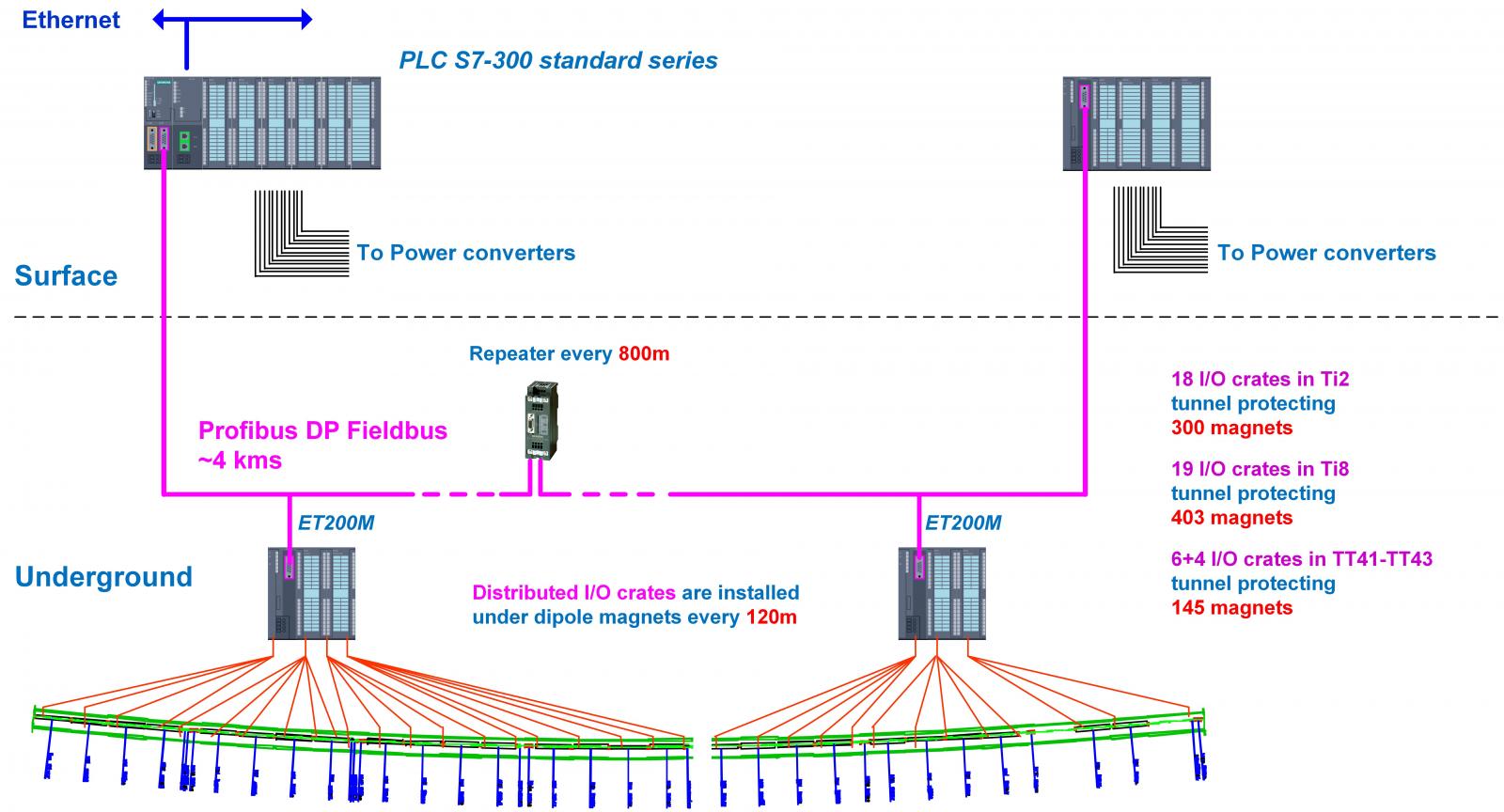THE WARM MAGNET INTERLOCK CONTROLLER (WIC)
THE PRINCIPLE:
The WIC is a PLC based system (Programable Logic Controller).
It protects the normal conducting magnets from overheating by switching off the corresponding power converter when a fault occurs (magnet overheating, lack of water flow…).
It can also be interfaced with the Beam Interlock System (BIS) to inhibit a beam injection or request a beam dump in case of a magnet or power converter fault in order to prevent beam-induced damage to accelerator’s equipment.
It is provided with a SCADA supervision to monitor the status of an installation and logging of the data (i.e. faults are archived with accurate timestamps to retrace sequence of events).

Figure 1: Simplified layout of the WIC system
THE HARDWARE COMPONENTS:
The hardware used to build a WIC system is designed to be generic for all installations (to some extent).
It is divided into 4 main building blocks (assembled in 6U crates) that can be duplicated depending on the size of a given installation (i.e number of I/Os to connect):
- Power supply crate: it comprises two redundant power supplies to power the master crate and its deported units.
-Master crate: it comprises the CPU (where the process is running) and a communication processor (CP) for the connection to the CERN technical network for the supervision.
-Magnet deported crate: it comprises input modules to connect the magnet instrumentation (thermo-switches, flow-switches) and output modules for remote testing of the installation.
-Power converter deported crate: it comprises input and output modules to exchange signals with the power converters.
The communication between the master crate and its deported units is ensured via a Profibus DP fieldbus.
Depending on the configuration of an installation, the crates can be geographically distributed over several buildings or between surface and underground areas.

Figure 2: Example of WIC system topology in the LHC-SPS transfer lines
THE SCADA SUPERVISION:
A dedicated SCADA (Supervisory Control and Data Acquisition) tool (implemented in the case of the WIC application with WinCC Open Architecture) is provided for each installation for monitoring, controlling of the WIC system and data logging.
Figure 3: Human Machine Interface (HMI) for the LHC machine
A typical faceplate of a WIC system is composed of two different kind of widgets:
• The “Magnet” widgets
• The “Power converter” widgets
By clicking on a widget, the status of each I/Os is displayed in a graphical form.
Figure 4 : The CERN Accelerator Complex
CERN'S CURRENT AND FUTURE ACCELERATORS
Linear accelerator 3 (LINAC3 - Covered by the WIC)
Linac 3 is the starting point for the ions used in physics experiments at CERN
The Low Energy Ion Ring (LEIR - Covered by the WIC)
LEIR takes long pulses of lead ions from Linac 3 and transforms them into the short, dense bunches suitable for injection to the Large Hadron Collider
Linear accelerator 4 (LINAC4 - Covered by the WIC)
Linac 4 boosts negative hydrogen ions to high energies. It will become the source of proton beams for the Large Hadron Collider in 2020
The Proton Synchrotron Booster (BOOSTER - Covered by the WIC)
Four superimposed synchrotron rings receive protons from the linear accelerator, boost them to 800 MeV and inject them into the Proton Synchrotron
The Proton Synchrotron (PS - Partially covered by the WIC)
A workhorse of CERN's accelerator complex, the Proton Synchrotron has juggled many types of particle since it was first switched on in 1959
The Super Proton Synchrotron (SPS - Covered by the WIC)
The second-largest machine in CERN’s accelerator complex provides a stepping stone between the Proton Synchrotron and the LHC
The Large Hadron Collider (LHC - Covered by the WIC)
The 27-kilometre LHC is the world's largest particle accelerator. It collides protons or lead ions at energies approaching the speed of light
LINKS TO EXPERIMENTAL FACILITIES :
AWAKE (Covered by the WIC)
ELENA (Covered by the WIC)
EAST AREA (Covered by the WIC)
HiRadMat (Covered by the WIC)
ISOLDE/HIE-ISOLDE (Covered by the WIC)
NToF (Covered by the WIC)
